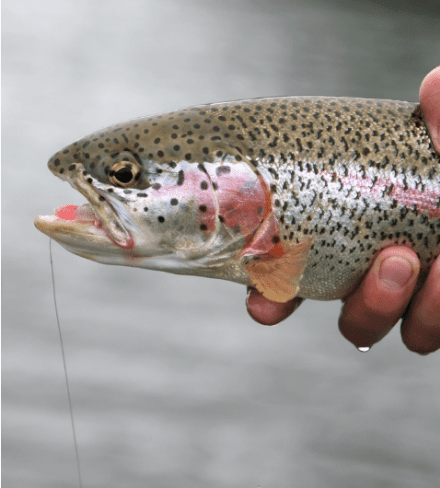Hybrid Cut-Bow Trout Information
Hybrid Cut-Bow Trout
Fly fishing enthusiasts always seek unique and exhilarating species to challenge their angling skills. One such captivating fish is the Hybrid Cut-Bow Trout. This remarkable hybrid combines two renowned trout species: the Rainbow Trout and the Cutthroat Trout. This article will explore the world of Hybrid Cut-Bow Trout, including its origins, physical characteristics, spawning habits, size, preferred habitats, fly fishing techniques, and more. Get ready to embark on an exciting fly fishing journey with the Hybrid Cut-Bow Trout.
Origin and Background
The Hybrid Cut-Bow Trout is an intriguing fish that originated from crossbreeding rainbow trout (Oncorhynchus mykiss) and cutthroat trout (Oncorhynchus clarkia) species. This unique hybridization resulted in a fish that combines the vibrant colors of rainbow trout with the distinctive markings of cutthroat trout. The Hybrid Cut-Bow Trout was introduced in Colorado's lakes and rivers as part of a conservation effort to enhance the diversity of the fish population and enrich the angling experience.

Physical Characteristics
What sets the Hybrid Cut-Bow Trout apart is its captivating array of colors. It features the signature pinkish-red stripe along the lateral line, reminiscent of the cutthroat trout. Additionally, its sides shimmer with a mesmerizing range of rainbow-like iridescent hues, ranging from vivid pinks and oranges to deep blues and greens. These striking colors make the Hybrid Cut-Bow Trout a highly sought-after catch among anglers.
Spawning Habits
The Hybrid Cut-Bow follows a spawning pattern similar to its parent species. Spring is the prime spawning season, as water temperatures rise, providing favorable conditions for successful reproduction. During this time, the female trout creates a nest, known as a redd, by displacing gravel and debris on the riverbed. She deposits her eggs in the redd, while the male fertilizes them externally. Once spawning is complete, both male and female trout return to their respective habitats.
Characteristics of Habitat, Size, and Diet Preferences
The Hybrid Cut-Bow Trout is adaptable to different aquatic environments found exclusively in Colorado. It thrives in cold, clear waters with ample oxygen levels, exhibiting a preference for moderate to fast-flowing currents in rivers. In lakes, it tends to inhabit nearshore areas. Some specific lakes where the Hybrid Cut-Bow Trout can be found include Lake Granby, Blue Mesa Reservoir, and Twin Lakes. In rivers, it can be observed in the Arkansas River, Colorado River, and South Platte River, among others. These unique habitats contribute to the trout's remarkable ability to thrive in diverse settings.
Their diverse diet includes aquatic insects, including mayflies, caddisflies, stoneflies, small fish, crustaceans, and even terrestrial insects. This adaptability allows them to survive in different habitats. The growth rate of Hybrid Cut-Bow Trout depends on factors like food availability, water temperature, and genetics. They can reach average lengths of 14 to 18 inches within the first few years, with some individuals growing even more significant, exceeding 20 inches. Their impressive size makes them a popular target for anglers.
The Hybrid Cut-Bow Trout is a unique species that thrive in Colorado's diverse aquatic ecosystems. With its vibrant colors, unique hybrid origin, and remarkable growth potential, it captivates the interest of anglers. Gaining insights into their spawning habits, preferred habitats, and feeding behavior enables us to understand the significance of conserving this remarkable trout species. So, watch for the Hybrid Cut-Bow whenever you explore Colorado’s waters and savor the thrill of encountering this mesmerizing fish!
